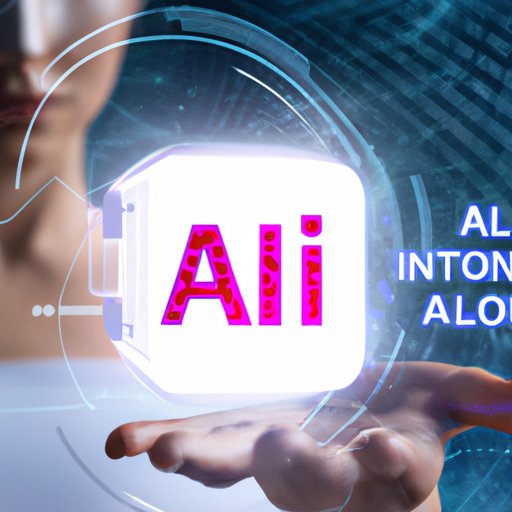Introduction
Artificial intelligence (AI) is a rapidly developing field of computer science that focuses on creating machines that can think and act like humans. AI has become increasingly popular in recent years due to its many potential applications, from automation and robotics to machine learning and predictive analytics. In this article, we will explore the definition of AI, the ways it can be applied in everyday life, and its potential for changing the world.
A Beginner’s Guide to Artificial Intelligence (AI)
Before exploring the benefits and challenges of AI, it is important to understand what AI is and how it works. AI is a broad term used to describe any system that can “learn” from its environment and use that knowledge to make decisions or take action. It can be used to automate mundane tasks, enable machines to learn from data, and much more.
How can AI be applied in everyday life? AI can be used in a variety of ways, from helping to diagnose medical conditions to powering self-driving cars. It can also be used in marketing, finance, and customer service, among other areas. In addition, AI can be used to create virtual personal assistants, such as Apple’s Siri and Amazon’s Alexa, which can answer questions and complete tasks.
What are the different types of AI? There are several different types of AI, each of which has its own set of applications. These include: supervised learning, unsupervised learning, deep learning, reinforcement learning, and natural language processing. Each type of AI has its own strengths and weaknesses, so it is important to choose the right type for your specific application.

Exploring the Benefits of Artificial Intelligence
One of the main advantages of AI is increased efficiency. By automating tedious or repetitive tasks, AI can help businesses save time and money. This can be especially helpful for large organizations, where manual tasks can take up a significant amount of time and resources.
AI can also be used to improve decision-making. By analyzing large amounts of data, AI systems can identify patterns and make predictions that would otherwise be difficult or impossible for humans to detect. This can help businesses make better decisions, such as identifying customer trends or predicting the outcome of certain events.
Finally, AI can help businesses save money. By automating processes, businesses can reduce their labor costs and increase their overall productivity. Additionally, AI can be used to identify cost savings opportunities, such as reducing energy consumption or optimizing supply chains.
How AI is Changing the World Today
AI is already having a major impact on our lives. Automation has been used for decades to streamline processes and reduce costs, but AI has taken this to a new level. AI-powered robots are now being used to automate a wide range of tasks, from manufacturing products to providing customer service. This can help businesses save time and money, while freeing up employees to focus on more complex tasks.
Machine learning is another application of AI that is having a major impact on the world today. Machine learning algorithms can be used to analyze large amounts of data and identify patterns that would otherwise be too difficult or time-consuming for humans to detect. This can be used to help businesses make better decisions, predict customer behavior, and optimize processes.
Robotics is also becoming increasingly common in the world today. AI-powered robots can be used to automate a variety of tasks, from sorting mail to performing surgery. This can help businesses save time and money, while also increasing safety and accuracy.

The History and Future of Artificial Intelligence
The history of AI dates back to the 1950s, when computers were first developed. Early AI research focused on creating machines that could think and act like humans, but these efforts were largely unsuccessful. However, advances in computer technology over the past few decades have allowed AI to develop at an unprecedented rate.
Today, AI is making major advances in a variety of fields. From medical diagnosis to autonomous vehicles, AI is being used to automate and optimize processes in ways that were previously thought impossible. In the future, AI is expected to become even more powerful, with applications ranging from intelligent robots to automated legal services.

AI: The Pros and Cons of Its Use
Like any technology, AI has both advantages and disadvantages. On the plus side, AI can help businesses save time and money by automating mundane tasks, optimizing processes, and improving decision-making. Additionally, AI can be used to create personalized experiences for customers, such as virtual personal assistants.
On the other hand, AI can also have negative consequences. For example, AI-powered automation can lead to job losses, as machines can do certain tasks more efficiently than humans. Additionally, AI systems can be prone to bias if they are not carefully designed and tested.
Conclusion
In conclusion, AI is a rapidly developing field of computer science that has the potential to revolutionize the way we live and work. From automation to machine learning, AI is being used in a variety of ways to increase efficiency, simplify processes, and improve decision-making. While there are both advantages and disadvantages associated with AI, its potential for transforming the world is undeniable.
(Note: Is this article not meeting your expectations? Do you have knowledge or insights to share? Unlock new opportunities and expand your reach by joining our authors team. Click Registration to join us and share your expertise with our readers.)
